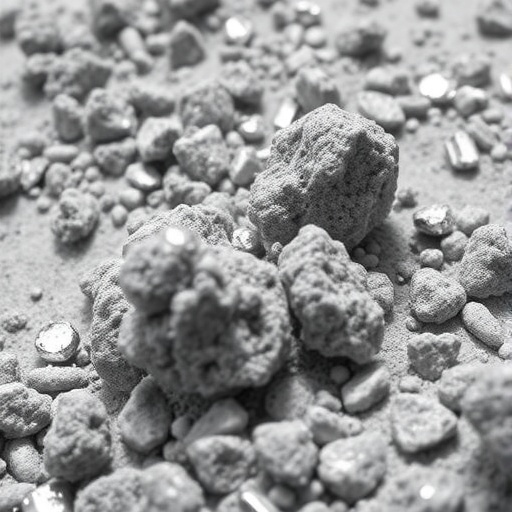In recent years, there has been a significant push toward developing sustainable and efficient energy storage solutions. As the demand for renewable energy sources grows, researchers globally are exploring various materials that can serve as effective components in batteries. One noteworthy study highlights the potential of naturally occurring ilmenite sourced from Egyptian black sand as an innovative anode material for lithium-ion batteries. This breakthrough could pave the way for more sustainable and efficient battery technology, which is essential for reducing our carbon footprint, especially in the context of the increasing reliance on electric vehicles and renewable energy systems.
The emergence of lithium-ion batteries has revolutionized energy storage, enabling the proliferation of portable electronic devices and electric vehicles. However, the quest for new and more efficient battery technologies continues as researchers aim to enhance performance metrics such as energy density, charge/discharge rates, and cycle life. Traditional anode materials, primarily graphite, have limitations in terms of their energy capacity and structural stability. Therefore, the exploration of alternative materials has become a focal point in battery research. The findings from this study, which evaluate ilmenite, may lead to significant advancements in this vital area.
Ilmenite is a naturally occurring mineral primarily composed of iron titanium oxide (FeTiO3). Its abundance in nature, particularly in regions such as Egypt where black sand deposits are rich in this mineral, positions it as a promising candidate for battery applications. The research conducted by Abbas et al. meticulously investigates the electrochemical properties of ilmenite, revealing its potential to function effectively as an anode material in lithium-ion batteries. Anodes play a crucial role in determining a battery’s capacity and longevity, making this research particularly significant.
In the laboratory, researchers systematically synthesized ilmenite-based electrodes and subjected them to a series of electrochemical tests. The results indicated that ilmenite exhibits excellent charge storage capabilities due to its unique structural properties. Furthermore, the lattice dynamics of ilmenite provide it with a distinctive ability to intercalate lithium ions, which enhances overall battery efficiency. The study noted a substantial improvement in the cycle stability of the batteries using ilmenite as an anode compared to conventional graphite counterparts.
One of the remarkable aspects of using natural minerals like ilmenite is their environmental impact. While the mining and processing of conventional battery materials often come with significant ecological consequences, ilmenite mining is relatively less harmful, making it a greener alternative. This aligns well with the overarching goals of sustainable technology: reducing environmental degradation while improving energy storage systems. The authors of the study emphasize that utilizing locally sourced minerals also reduces transportation emissions, addressing several environmental concerns associated with battery production.
Another key finding from this research pertains to the cost efficiency of employing ilmenite as an anode material. Compared to synthetic alternatives, ilmenite is widely available and can be processed at a lower cost. This could potentially translate into lower manufacturing costs for lithium-ion batteries, leading to more affordable electric vehicles and energy storage systems. As the price of electric vehicles is often cited as a barrier to wider adoption, the introduction of cost-effective materials could help bridge the gap between technology and consumer accessibility.
Moreover, the study explores the stability of ilmenite under various operating conditions. Battery performance can significantly diminish due to temperature fluctuations, moisture, and other environmental variables. The resilience of ilmenite in diverse conditions suggests that batteries employing this mineral could maintain their performance under a wider range of operating environments, making them more reliable for various applications—from electric cars to grid storage solutions.
In addition to performance metrics, the research team focused on the sustainability profiles of ilmenite-based batteries. The life cycle assessment conducted within the study indicates that batteries using ilmenite have a reduced carbon footprint throughout their entire life cycle, from material extraction to disposal. This is a critical consideration as we move towards a circular economy that prioritizes resource efficiency and minimal waste.
The implications of this research extend beyond just battery technology; they add to the broader discourse on sustainability and innovation in materials science. As ilmenite becomes a contender for battery production, it encourages the scientific community to look back to natural resources to solve modern technological challenges. The natural world often holds the key to innovative solutions, and ilmenite’s unique properties exemplify this idea beautifully.
In conclusion, the research conducted by Abbas and colleagues suggests a promising avenue for the future of lithium-ion batteries through the sustainable utilization of ilmenite. As the need for environmentally friendly and efficient energy storage solutions becomes increasingly critical, this study marks a significant step toward harnessing natural resources for technological advancement. By integrating such materials into mainstream battery production, we can fortify our commitment to sustainability while catering to the ever-evolving demands of the energy sector.
Thus, ilmenite from Egyptian black sands emerges not just as a mineral of interest but as a pivotal player in the future landscape of battery technology. As we continue to explore and innovate, embracing natural resources like ilmenite could lead us to a more sustainable and efficient energy future—one where the intersection of nature and technology leads to unprecedented advances in how we store and utilize energy.
Subject of Research: Ilmenite as an anode material for lithium-ion batteries
Article Title: A natural occurring ilmenite from Egyptian black sand as an anode for lithium batteries
Article References:
Abbas, S.M., Fayed, M.G., Abdel-Ghany, A.E. et al. A natural occurring ilmenite from Egyptian black sand as an anode for lithium batteries.
Ionics (2025). https://doi.org/10.1007/s11581-025-06646-x
Image Credits: AI Generated
DOI: https://doi.org/10.1007/s11581-025-06646-x
Keywords: Ilmenite, Lithium-ion batteries, Sustainable materials, Electrode performance, Battery technology, Carbon footprint.




